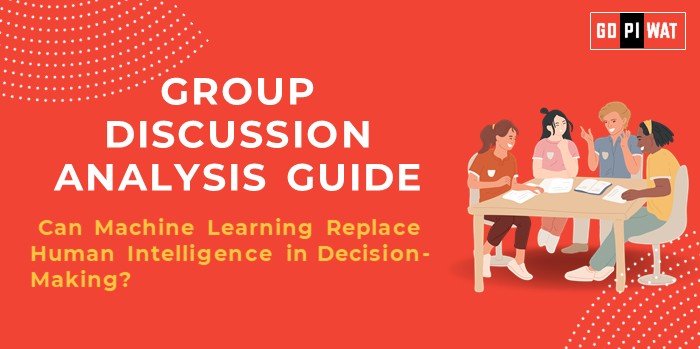📋 Group Discussion Analysis Guide: Can Machine Learning Replace Human Intelligence in Decision-Making?
🌐 Introduction to the Topic
Machine learning (ML) has become integral to decision-making across industries, sparking debate about its potential to replace human intelligence. In a data-driven world, understanding this topic connects with themes of innovation, ethics, and leadership.
- Opening Context: ML empowers decision-making in areas like healthcare, finance, and logistics but raises concerns about ethics and adaptability.
- Background: ML advancements in deep learning and neural networks have enabled algorithms to surpass humans in specific tasks. However, ethical, social, and reliability challenges remain unresolved.
📊 Quick Facts and Key Statistics
- Global AI Market Size (2024): $309.6 billion—highlighting the scale of AI adoption.
- Human Error in Accidents: 94% (NHTSA, 2023)—demonstrating ML’s potential to reduce human mistakes.
- Algorithm Bias Incidents (2023): Over 200 globally reported cases—emphasizing ethical concerns.
- Healthcare Diagnostics Accuracy: 87% with ML compared to 75% by humans (Stanford AI Lab, 2023).
🔑 Stakeholders and Their Roles
- Governments: Regulating AI ethics and ensuring equitable implementation.
- Tech Companies: Innovating responsibly and ensuring fairness in deployment.
- Citizens: Beneficiaries of improved services, but also impacted by ethical risks.
- Academia: Pioneering advancements while addressing ethical concerns.
- NGOs: Advocating for responsible AI and unbiased practices.
🎯 Achievements and Challenges
🏆 Achievements
- Enhanced predictive analytics in sectors like healthcare, finance, and retail.
- Automation of repetitive tasks, saving industries $20 billion annually.
- Improved accessibility with AI-powered tools for individuals with disabilities.
⚠️ Challenges
- Ethical Concerns: Bias in algorithms can lead to discriminatory outcomes.
- Accountability Issues: Assigning responsibility for ML-based errors.
- Human Job Displacement: Significant workforce reductions in some sectors.
🌍 Global Comparisons
- Success: Estonia’s e-governance thrives on AI for efficiency.
- Struggles: China’s social credit system highlights ethical challenges.
📋 Structured Arguments for Discussion
- Supporting Stance: “ML enables faster and more accurate decisions, especially in data-intensive fields like healthcare.”
- Opposing Stance: “Human intelligence is irreplaceable due to adaptability and ethical reasoning.”
- Balanced Perspective: “ML complements human intelligence but cannot fully replace contextual and ethical nuances.”
💡 Effective Discussion Approaches
- Opening Approaches:
- “AI-enabled diagnostics improve accuracy by 12% over human performance in medical fields.”
- “How can we trust systems exhibiting bias for ethical decision-making?”
- Counter-Argument Handling:
- Emphasize the importance of human oversight in unpredictable scenarios.
- Point out advancements in AI-human collaboration for ethical and contextual decisions.
📈 Strategic Analysis of Strengths and Weaknesses
- Strengths: Enhanced efficiency, reduced errors, scalability.
- Weaknesses: Ethical concerns, lack of contextual understanding.
- Opportunities: AI-human collaboration, better personalization.
- Threats: Over-reliance on flawed algorithms, regulatory hurdles.
🌍 Connecting with B-School Applications
- Real-World Applications: Strategy in operations, risk assessment, and HR analytics.
- Sample Interview Questions:
- “What industries benefit most from ML replacing human intelligence?”
- “Discuss a scenario where ML’s limitations hinder decision-making.”
- Insights for B-School Students: ML knowledge is critical for roles in analytics, innovation management, and operational leadership.


